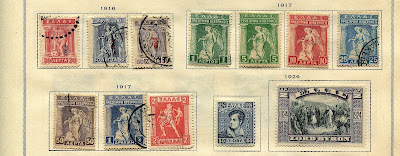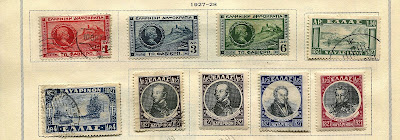Hermes (1)
Bud's Big BlueBud's Observations
Hermes (Mercury) monopolizes the first 40 years of Greek
stamps then, with the help of other Olympians and their lessers, continues to
predominate through the end of the classical era, cresting with the spectacular
airmails of 1933.
It's not surprising. Known for his fancy footwork, Hermes traveled
freely between the mortal and divine worlds as a luck-bringing messenger of the
gods. He was conceived and born in a single day, then leaped from his crib to
steal Apollo’s cattle. Apollo forgave him and, in trade for a lyre Hermes had
fashioned, let him keep the cows.
So, Hermes is thought to rule over trickery, trade,
travelers, border crossings, and thieves -- all of which appertains to
world-wide stamp collectors. He’s our guy.
The first supplement page shows an assortment of Hermes
heads, organized by face value, awaiting proper identification according to the
Hellas Catalogue. Their tribe has
increased since the scan was made.
Hermes crosses many of Big Blue’s philatelic borders. His
likeness appears on stamps of Hamburg, Australia, Brazil, Austria, Portugal, Liberia,
and Uruguay, among others. His winged hat pops up on US E7, presumably to
ensure prompt special deliveries.
Curiously, the stamp designs authorized by the Greek
Republic, beginning in 1924 and continuing for about a decade, abandon the
gods. More recent heroes were chosen instead -- Lord Byron, General Fabvier,
three admirals, and the like. By 1933 the gods were returning, supremely so
with the airmails mentioned above and the Pallas Athena 1937 3 cent.
Which reminds me of David Bowie’s “Pallas Athena,” the grim,
ominous lyrics of which are:
God is on top of it all
That’s all
Holds true, it would seem, for early Greek stamps.
David Bowie, a modern
Hermes commemorated on a 2017 UK stamp
Error alert: The first Health allegory on page 9 should be
RA 49, not RA 52. The RA 52 has been swapped for the RA 49 showing in the
supplement pages.
Census: 281 in BB spaces, three tip-ins, 181 on supplement
pages, expanded to 249 since the scans were made. Additions are mostly BOB,
Turkish occupation, etc., and Hermes heads
-----------------------------------------------------------------------------------------
[1] In my collection. Bronze, after the antique,
but older than the Hermes heads
The first stamps for Greece were the large Hermes Heads, followed by the small Hermes Heads between 1886-1895, and then a pictorial series for the first modern Olympic Games held in Athens in 1896.
As one can imagine, the classic designs combined with ancient Greece classical motifs have made Greek stamps highly popular among philatelists right from the beginning.
For those puzzled by the complicated catalogue parsing for the large Hermes Heads, check out my "Hermes Heads" blog post (link below).
Greece Blog Posts & BB Checklist
Greece Hermes Heads
Greece 1896-1940
Greece: BOB, Balkan Wars
Page 1
1a
1b
1c
1d
Page 2
2a
2b
2c
Page 3
3a
3b
3c
Page 4
4a
4b
4c
Page 5
5a
5b
5c
Page 6
6a
6b
6c
Page 7
7a
7b
7c
Page 8
8a
8b
Page 9
9a
9b
9c
Page 10
10a
10b
10c
Supplements
Page 1
Page 2
Page 3
Page 4
Page 5
Page 6
Comments appreciated!
















































Lovely stamps, I particularly like the air mail issues which look like tiny watercolor paintings.
ReplyDelete